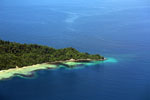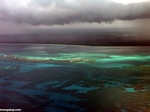With humans scattered throughout the globe, it is hard to imagine lands still unexplored or species undocumented. Yet, on the remote French Polynesian Gambier Islands a new coral reef species has been found thriving in underwater lagoons. Echinophyllia tarae was discovered by marine biologist Francesca Benzoni and the research crew members of the Tara Oceans International Research Expedition.
The recently discovered species is the newest member of Echinophyllia, a genus of coral whose members are found in the Indo-Pacific Ocean from the tropical waters of the Indian Ocean to the western and central Pacific Ocean. Benzoni and her team discovered Echinophyllia tarae while sampling 24 sites along the lagoons of the Gambier Islands located at the southeast tip of French Polynesia. Due to the remoteness of the islands, the last recorded study of these corals was conducted by naturalist Jean-Pierre Chevalier in the mid seventies. During his 1974 exploration, Chevalier observed a dominant presence of the species Echinophyllia aspera. When Benzoni explored the lagoons, she didn’t find any Echinophyllia aspera, but instead discovered an undescribed species, Echinophyllia tarae.
 The new coral species Echinophyllia tarae is distinguished by its brown mottled coloration. Photo by: Francesca Benzoni. |
Benzoni believes that Chevalier may have found and collected Echinophyllia tarae and thought it was Echinophyllia aspera, but since his collection cannot be located, this cannot be confirmed.
“Dr. Chevalier had an incredible knowledge of corals,” Benzoni told mongabay.com. “It is my personal opinion he did find and collect E. tarae, but thought it was E. aspera. The genus Echinophyllia, like several other genera of scleractinian corals is not very well studied. Because corals are so morphologically variable, it is not uncommon that we collect samples because they look somehow not typical of the known species and find out later, once we study the collection, that we actually collected a new guy.”
Characteristic of the Scleratinia family, Echinophyllia tarae produces a hard, rigid skeleton composed of calcium carbonate and, like the eight other species of its genus, has a mutualistic relationship with photosynthetic algae living in its tissue. Echinophyllia tarae commonly grows on the tissue fragments of dead coral and inhabit the muddy environment of reefs at depths between 5 and 20 meters (16-66 feet) on both well-lit and shady surfaces. Patterns of partial death and regeneration within colonies are common and may be due to competition with other benthic invertebrate species. Echinophyllia tarae can be distinguished from other Echinophyllia species by its large polyps, mottled browns or bright green coloration and small colony formation. The species was named after Tara, the exploration vessel that housed the researchers who discovered it. This name is doubly significant, as in the Polynesian language it also is used to denote spiny, pointed objects, as well as a sea goddess.
This new discovery adds insight into the mysterious diversity of hard corals, as well as their biology, evolution, and biogeography. It also sparks further curiosity as to whether there are more underwater spiny, sea goddesses yet to be discovered in remote areas? However, future research of hard coral species could be hindered by current threats of global climate change, ocean acidification and human induced changes to reef structures.
Citations:
- Benzoni, Francesca. “Article for Mongabay.com.” E-mail interview. 27 Nov. 2013.
- Benzoni F (2013) Echinophyllia tarae sp. n. (Cnidaria, Anthozoa, Scleractinia), a new reef coral species from the Gambier Islands, French Polynesia. ZooKeys 318: 59, doi:10.3897/zookeys.318.5351.
- EurekAlert! A New Coral Reef Species from the Gambier Islands, French Polynesia.Back to EurekAlert! AAAS, 26 July 2013. Web. 22 Nov. 2013. .
Related articles
Sea and storm: coastal habitats offer strongest defense

(10/11/2013) Surging storms and rising seas threaten millions of U.S. residents and billions of dollars in property along coastlines. The nation’s strongest defense, according to a new study by scientists with the Natural Capital Project at the Stanford Woods Institute for the Environment, comes from natural coastal habitats.

(10/03/2013) The oceans are more acidic now than they have been for at least 300m years, due to carbon dioxide emissions from burning fossil fuels, and a mass extinction of key species may already be almost inevitable as a result, leading marine scientists warned on Thursday. An international audit of the health of the oceans has found that overfishing and pollution are also contributing to the crisis, in a deadly combination of destructive forces that are imperiling marine life, on which billions of people depend for their nutrition and livelihood.
Shark overfishing hurts coral reefs
(09/20/2013) Overfishing for sharks is having detrimental effects on coral reefs, finds a new study published in the journal PLOS One.
Mesoamerican Reef needs more local support, says report
(09/13/2013) From massive hotel development through the agriculture industry, humans are destroying the second largest barrier reef in the world: the Mesoamerican Reef. Although global climate change and its effects on reefs via warming and acidification of coastal waters have made recent headlines, local human activities may destroy certain ecosystems before climate change has a chance to do it. The harmful effects of mining, agriculture, commercial development, and fishing in coastal regions have already damaged more than two-thirds of reefs across the Caribbean, in addition to worsening the negative effects of climate change.
Finding a needle in a haystack: two new species of octocorals discovered in the Pacific Ocean

(09/04/2013) The vast expanse of the Earth’s oceans makes finding a new species like finding a needle in a haystack. In fact, finding a needle in a haystack may be easier than finding a new species of octocoral in the Pacific Ocean. But Gary Williams with the California Academy of Sciences has recently found not only one but two new species, including a new genus of octocoral.
Google Earth presents fish-eye view of coral reefs
(08/20/2013) You can now visit up-close and personal some of the world’s most imperiled ecosystems on Google Earth: coral reefs. The Google team is working with scientists to provide 360 degree panoramas, similar to Google street-view, to give armchair ecologists a chance to experience the most biodiverse ecosystems under the waves.
U.S. bombs Great Barrier Reef, promises ‘rapid recovery’ of armaments
(07/23/2013) Four unarmed bombs dropped by the US military into the Great Barrier Reef Marine Park pose a low risk to wildlife and a joint mission will aim for their “rapid recovery”, according to the government agency in charge of the reef. The Great Barrier Reef Marine Park Authority said two of the bombs are inert, containing concrete, while the other two were not armed, making the chance of detonation “extremely low”.
Logging endangers UNESCO World Heritage Site in Solomon Islands
(06/22/2013) A world heritage site in the Solomon Islands is ‘in danger’ due to logging, warns the United Nations Educational, Scientific and Cultural Organization (UNESCO).
UN may downgrade Great Barrier Reef’s heritage status due to Australia’s inaction on threats
(06/17/2013) The federal government insists it is striving to avoid the Great Barrier Reef being listed ‘in danger’ ahead of a crunch UN meeting, after rejecting a Senate recommendation to block new port developments near the World Heritage ecosystem.
(05/15/2013) With islands and atolls scattered across the ocean, the small Pacific island states are among those most exposed to the effects of global warming: increasing acidity and rising sea level, more frequent natural disasters and damage to coral reefs. These micro-states, home to about 10 million people, are already paying for the environmental irresponsibility of the great powers.
Samsung admits to using tin linked to child labor, deforestation; Apple mum on sourcing

(04/25/2013) Mobile device giant Samsung has admitted to using tin sourced from a controversial mining operation on the Indonesian island of Bangka, where unregulated mining kills 150 miners a year and causes substantial environmental damage, reports The Guardian and Mongabay-Indonesia.
(04/15/2013) What do you do when you’re smuggling 22,000 pounds of an endangered species on your boat? Answer: crash into a protected coral reef in the Philippines. Last Monday a Chinese vessel slammed into a coral reef in the Tubbataha National Marine Park; on Saturday the Filipino coastguard discovered 400 boxes of pangolin meat while inspecting the ship. Pangolins, which are scaly insect-eating mammals, have been decimated by the illegal wildlife trade as their scales are prized in Chinese Traditional Medicine and their meat is considered a delicacy.
